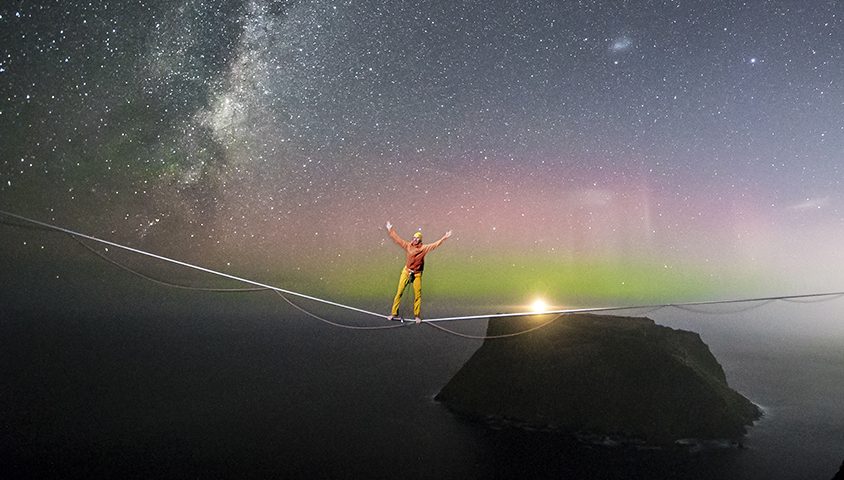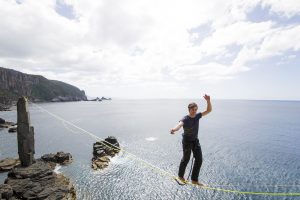It sounds like a quick progression: from slacklining in local parks to highlining some of the most challenging spots in the world.
But for Valentin Rapp, the change in scale was just what he was after. As a highliner, photographer and filmmaker, Rapp’s inspiration is largely drawn from athletes ‘pushing their own boundaries’ – something he’s no0w familiar with from highlining all around the world.
We recently spoke to Rapp to learn more about his trip and how he mentally and physically prepared to travel his unique ‘Path of the Sky’ in Tasmania.
How did the expedition come about?
We are always looking for unique spots to rig our highlines we heard about the famous sea cliffs in Tasmania. After seeing some photos of them we knew we had to go there. Lukas and I got in contact with two guys called Max and Preston from the US who Lukas had highlined with before and they were also keen on exploring the island.
To get to the cliffs, you have to trek 18 kilometres through the decidedly unglamorous Tasmanian undergrowth.
Can you tell us a little more about that journey, the challenges involved and how it shaped your experience as a whole?
In Tasmania, you never know what to expect from a trail by looking on the map. It is very hard to judge how long it will take you from point A to B when you only have the thin line on the paper. We had not expected the bush to be as dense as it was and how hard it would be to haul our big heavy backpacks through it. Wet feet is also something we had to get used to. When we started the hike we tried to avoid the puddles on the trail but after a couple of hours it was clear that it is just too much work to always try to avoid them and we started wading through the leech infested mud. As we were limited on what we could take with us we knew that this meant cold and wet feet for the next few days because there was no possibility of drying our clothes and shoes. But I guess this was again a big part of the ‘enjoyable suffering’ that made the whole trip an adventure that will be kept in our minds.
In your film and in other interviews, you’ve spoken about falling on the line. How do you deal with something like that?
Failing is part of every sport, I guess. In highlining every day is different. On some days you really fight hard with your own mental strength and it is very demanding to get back up again and motivate yourself to try the walk again, and on other days you are relaxed and able to just set one foot after the other till you are at the end of the line. Days like these keep me motivated to get out there again and again.
How do you mentally and physically prepare for an expedition like this?
You never know exactly what to expect so it is very difficult to prepare mentally. I would say hope for the best and expect the worst. It can always happen that the project doesn’t work out for numerous reasons. We knew that there would be long hikes to get to the spots, so we prepared ourselves for long days of walking. But what we didn’t expect was how hard bush bashing through the Tasmanian forest would be.
What does it take to be a good highliner? Can anyone do it?
It takes a lot of ambition to be a good highliner. To be ready for the first highline it took me countless hours of practising on a normal slackline. But besides the fact that it takes a lot of physical exercise it super important to know how to set it up safely. The best thing to do when starting to highline is joining experienced people who know how to rig it in a safe way. When you have good highliners around you, they can give you important tips for overcoming your fear on your first steps.
How do you go about setting up your rigging?
The rigging totally depends on the spot where you want to set it up. The main three questions to consider while planning are:
- how to get there
- how to establish a connection between the two points
- how to anchor the line in a safe way
Planning is always key, especially when there is a long hike or climb to reach the spot because you don’t want to bring unnecessary gear. In Tasmania for example, we contacted local climbers in this area. Pictures of the rock formations can give you important hints on how to set up the connection and the anchors. You always have to come up with creative ideas, especially for the connection.
When it is not possible to rappel on both sides and make a knot in the middle you have to find another way to get the line across – a bow and arrow, slingshot or a drone for example.
When the connection is established, we always try to find natural anchors: rock formations or trees we can sling and rig the slackline from, so we leave no traces behind. When it comes to the line itself we can choose between different materials and thicknesses. Every line behaves in a different way because of the different stretch and weight so we use different lines for different lengths and purposes. That means a stiffer and lighter line for walking long highlines and one with more stretch and bounce for tricks and short highlines.
While there’s obviously the solo aspect to highlining, it seems that the community plays a very important role in the sport. How important is it to have a support network with you on expeditions?
As you can imagine, it is almost impossible to rig a highline on your own, especially in remote areas. It always takes a team of motivated and experienced athletes to successfully accomplish projects like the ones in Tasmania. Luckily the community of highliners all around the world is like a family. It doesn’t matter where you are, you will always find a place to stay and motivated slackliners to join you on your next adventure.
What is it about heading into the unknown (and all the hardships that come with it) that motivates you?
What makes an adventure a good one is when you can’t plan everything. It often involves hard work but that’s what makes the reward even more enjoyable. The unexpected is what motivates me the most. I often let things happen and then make the best out of it because it is more rewarding to me than already knowing what I will get beforehand.
How has exploring the unknown and the desire to find your own path influenced your photography and you as a person?
One main thing I have learned over the last years is to make something out of difficult situations. I’ve learned to overcome my own pain and capture other people in the same situation. You just get the best pictures in harsh and uncomfortable surroundings. Maybe that’s also something that changed me as a person, as I’m more positive in pushing forward.
You can more about Rapp’s story of highlining in Tasmania here.



